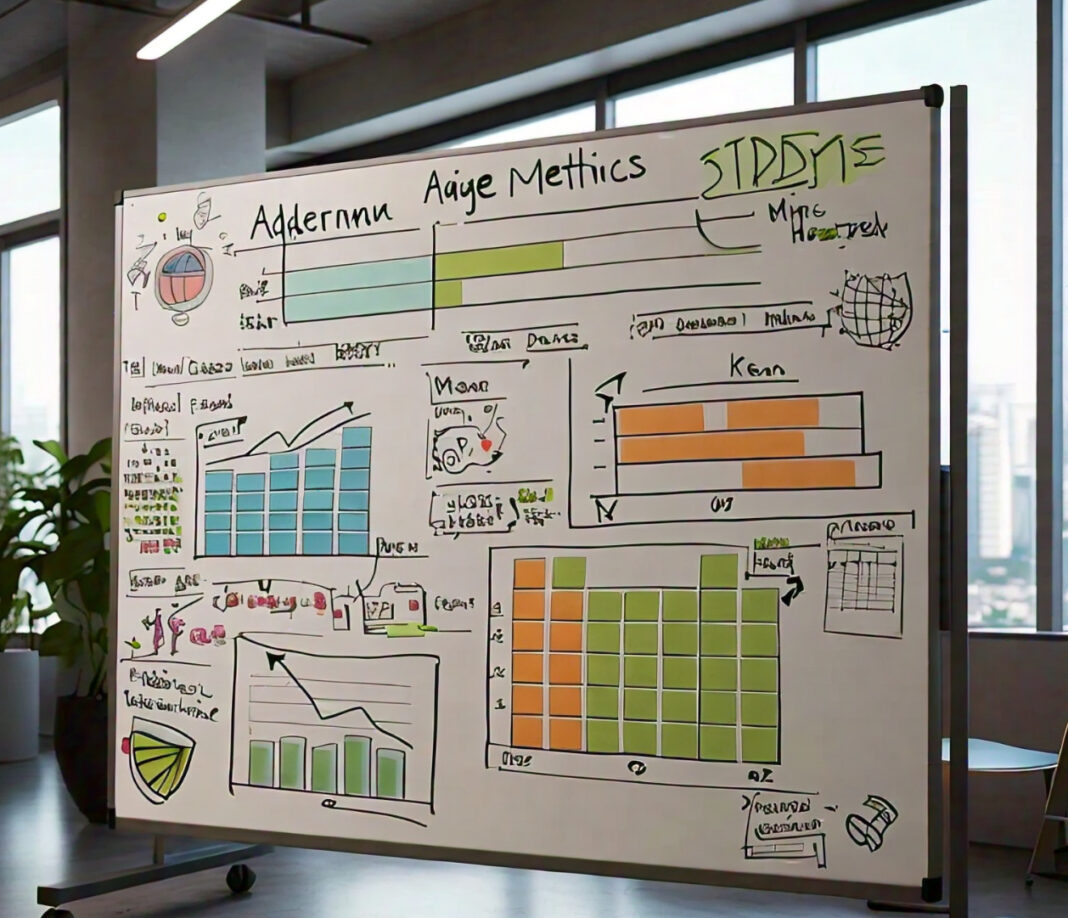Agile has evolved to be brought on the game changer approach concerning software development and project management. At its very core, Agile practices deliver values through iterative cycles. But to make sure that teams are performing effective work and projects are progressing as intended, it’s vital to measure performance and progress.

Agile metrics provide insights into diverse dimensions of a development process, from team productivity and quality to project timelines and stakeholder
satisfaction.
The comprehensive guide explored key Agile metrics used to measure team performance and progress, their meaning, and best practices to effectively leverage them.
Understanding Agile Metrics
1.1 Definition and Importance
Agile metrics are quantitative measures used to estimate different parameters of the Agile process.
They help teams understand their performance, improve in areas where they are inefficient, and
facilitate data-driven decision-making. The metrics are also capable of showing trends, diagnosing
problems, and leading to continuous improvement through providing feedback about different
elements of the development process.
1.2 Types of Agile Metrics
Agile metrics can be divided into several types, including:
- Performance Metrics: Measuring the efficiency and effectiveness of the development process.
- Progress Metrics: Tracking the advancement of work toward the achievement of project goals.
- Quality Metrics: Providing direct measures of the product’s quality.
- Predictive Metrics: Forecasting future performance and project timelines
Key Agile Metrics
2.1 Velocity
Definition: Velocity is therefore a metric representing how much work a team accomplishes
within a certain period of a sprint or iteration, generally computed by totaling story points, tasks, or
some other unit of work that was done within the timebox.
Importance: Helps teams know their ability to plan for future sprints most appropriately. Thus, in the most uncomplicated terms, velocity reflects the productivity of the team with
which trends are recognized.
How to Measure:
— Calculate: Sum up the total story points or work units, completed in one Sprint.
— Measure Over Time: The velocity must be measured over several Sprints to determine any
trends and make good projections.
Best Practices:
- Relative Estimations: Compare the work completed with the planned for relative consistency.
- Do not Over-Emphasize: Focus on trends and relative changes instead of stressing over the
numbers.
Example:
In such a condition where a team does 30 story points in Sprint 1 and 28 story points in Sprint 2,
then the average will be 29 story points per sprint.
2.2 Lead Time and Cycle Time
Lead Time and Cycle Time:
Lead Time: The total time taken from the creation date of a work item to its completion date.
Cycle Time: It refers to the period from when the work of a task gets started until the task is
done
** Importance **: Both lead time and cycle time give the impression of the process efficiency and
speed in churning out work items. This would help in detecting any choke points and areas of
possible process improvement.
*How to Measure:*
- Lead Time: Date stamping a work item when it enters the workspace and another when it is
marked as done. - Cycle Time: Measured time elapsed between starting to work on a task and the time when the
work is completed.
Best Practices - Monitoring Trends: Follow the changes in lead time and cycle time over a duration of
iterations to signal process improvements or issues. - Analyzing Bottlenecks: Leverage such metrics to identify at which stages in the
process, delays occur.
Example:
If a feature request was raised on 1 January and done on 15 January, the lead time would be 14 days.
If the development started on 5 January and finished on 10 January, it would be 5 days of cycle time.
2.3 Burndown Chart
Definition: A burndown chart is the graphical representation of work remaining against time. It
indicates the progress of the sprint or a project by drawing a graph of the remaining work normally in
story points or hours against the timeline.
Importance: These charts are important for a team to visualize its progress toward the
completion of the sprint or project goal. It gives a clear, real-time view of whether the team is on
track in completing the planned work.
To Determine:
- To know how much work remains: The graph should constantly be updated with the work
remaining. - To plot progress: Time vs work remaining is to be plotted.
Best Practices: - Regular Updating: It is to be updated and redrawn at very regular intervals.
- For Communication: Use it in communicating with the stakeholders to make the project status
fully transparent.
Example
In a two-week sprint, when 100 story points are targeted, the burndown chart will indicate a
decrease in the number of remaining story points during work completion.
2.4 Cumulative Flow Diagram (CFD)
Definition: A Cumulative Flow Diagram is a graphical representation of various stages of work
in the Kanban system; shows several work items in each stage of the workflow over time.
** Importance **: CFDs provide a view of the status/whereabouts of the work in the workflow.
Teams can identify bottlenecks or elements of workflow that are not working optimally. They
will be able to see how work flows through the system and get pointers to where work needs to be
streamlined.
** How to measure:**
- ** Track Work Items:** Work out the number of Work Items in every stage of workflow.
- ** Plot Over Time:** Plot the count of work items in every stage against a timeline.
** Best Practices ** : - Monitor Flow – Use the diagram to identify stages with too much work in process (WIP), and
as necessary, pay attention to and fix the bottlenecks. - Balance WIP – This implies that work across various stages should be evenly distributed to
achieve a smooth flow.
Example:
A CFD may indicate that it is “pushing” a lot more work items through the “In Progress” as
compared to the “Done” stage, thereby hinting towards a bottleneck.
2.5 Defect Density
Defect density is a measure of the number of defects seen in the product relative to its size, usually
expressed in defects per thousand lines of code or per story point.
Importance Defect density gives an idea of the quality of the product and the estimated level of
effectiveness it has gone through in both development and testing. It helps the teams know what to
focus on to better the quality of the product.
How to Measure:
- Count Defects: Number of defects reported during and after development.
- Calculate Density: The number of defects divided by the size of the product, such as lines of
code or story points.
Best Practices: - Monitor Trends: Defect density over time to know if quality is getting better or worse.
- Address Root Causes: Use defect data to address the development process leading to those
defects.
Example:
If 10,000 lines of code contain 50 defects, then the defect density is 5 defects per 1,000 lines of
code.
2.6 Team Satisfaction and Engagement
Definition: Team Satisfaction and Engagement parameters are used to measure the morale and
involvement levels of the team members. This can be measured through the survey, feedback forms,
or interviews.
** Importance**: High team satisfaction and engagement are the first pointers to productive and
quality levels. Engaged teams are likely to be motivated, collaborative, and committed to high-quality
delivery.
*How to Measure*:
- Surveys: Run regular surveys to understand the satisfaction and engagement levels of the team.
- Feedback Analysis: Look through feedback to understand areas that need to be worked on.
Best Practices: - Take Action Based on Insights: Work on the survey responses to streamline issues and boost
team morale. - Monitor Over Time: Trends of satisfaction and engagement to understand how group
dynamics develop.
Example:
An information collection can indicate the development of positive feelings among the employees
regarding their workplace. However, there are certain work-life issues that they are worried about.
Such conditions can lead to targeted improvements in team support.
Advanced Metrics and Techniques
3.1 Cumulative Lead Time Distribution
Definition: The Cumulative Lead Time Distribution metric reports lead times of completed
work items in a cumulative way, where we can see how lead times are spread and collected.
Importance: This metric helps a team understand the variability in lead times, which in turn will
identify the pattern or trend in how items are generally processed.
How to Measure:
- Track Lead Times: Track the lead times for every completed work item.
- Plot Distribution: Plot a cumulative distribution to visualize the spread of lead times.
Best Practices:
- Analyse Variability: Use the distribution to identify variability in lead times and address the root
causes. - Increase Predictability: There would be a need to reduce variability to increase predictability
and increase accuracy in planning.
Example: Cumulative distribution chart that shows for most of the items work may get done
within a certain range of time but a few items may have a high upper limit showing long lead times.
3.2 Value Stream Mapping
Definition: Value stream mapping is a mechanism that gives a team the ability to map and
analyze the flow of value during development. It becomes the mechanism used by teams in
identifying waste and optimizing the flow of work.
Importance: It provides a picture of how the work flows through the system from end to end. It
stores information and provides an overview of areas for improvement to attain efficiency in value
delivery.
**How to Measure: **
Map the Value Stream: Develop a value-stream map that includes steps and hand-offs in the
process. Analyze Flow: Identify the areas where delays or inefficiencies occur and analyze each.
Best Practices: Value Oriented: The value stream map is insistent on the flow of value rather than on the
sequence of steps. Continuous Improvement: Derive insights through the map for continuously
improving the process of value delivery.
Example:
A value stream map may indicate that the bottleneck is at the handoff between development and
testing, so there may be efforts at process improvement to reduce waste and delay and improve flow
through that step.
3.3 Predictive Metrics
Definition: Predictive metrics use past performance of data and the current status to be able to
predict future outcomes for instance project completion date or problems.
Importance: Help teams and stakeholders predict future performance. From those predictions
decisions can be made with a level of certainty.
How to Measure:
- Analyze Historical Data: Utilize historical performance data to uncover patterns and trends.
- Apply Predictive Models: Develop statistical or machine learning models to make projections
on the future based on current data.
Best Practices: - Leverage Multiple Models: Pool different predictive models to appear conclusive and reliable.
- Validate Predictions: Make periodical parallel comparisons of the prediction with the actual
and make corrections in the model, which increases forecasting ease.
Example:
A predictive model might thus forecast that a project would be completed in 8 weeks based on
current velocity and historical performance, to enable stakeholders to plan appropriately.
Best Practices for Using Agile Metrics
4.1 Align Metrics with Organizational and Team Goals
Ensure metrics are aligned with the goals and objectives set by the team and organization. Metrics
must provide information by which to make better decisions and drive improvements that lead to
the effective success of a project.
Best Practices:
- Clearly Define Goals: Set up clear goals about what is to be achieved from the metrics.
- Choose Relevant Metrics: Select those that directly contribute to the goals.
4.2. Focusing on Trends and Patterns
The metrics usage is all about trends and patterns and not the stand-alone data point only. Analyzing
a trend helps the team gain insights into the periodical performance and thereby make data-backed
improvements.
Best Practices :
- Track Over Time: Model metrics over a series of iterations or sprints to help to establish
trends. - Analyze Patterns: Identify the recurring patterns and correlations for deeper insights.
4.3 Avoid Overemphasizing Metrics
Although metrics are a handy tool, one should not over-emphasize the importance of them or use
metrics in a vacuum. Metrics are only one of the tools for the assessment of performance and
progress.
Best Practices:
- Use in Context: Consider metrics alongside qualitative feedback and other forms of
assessment. - Avoid Micromanagement: Use metrics to guide improvements, not to micromanage the team
members.
4.4 Include the Team
As much as possible, involve the team in choosing the different metrics and how to interpret them.
Engage the team to in a way bring relevance to the metrics and its understanding and use.
Best Practices:
- Seek Input: Involve team members in selecting metrics and interpreting results.
** Share Results:** Share the results of metrics with the team and interpret the impacts on
performance and process improvements.
4.5 Regularly Review and Adjust
It is incumbent upon the organization to try to see that metrics are periodically reviewed in line with
the project and team’s maturity to make any adjustments when the same is deemed necessary in the
future for relevance or effectiveness.
Best Practices
- Review – Contract reviews of metrics at fixed, regular intervals about their effectiveness.
- Be Adaptive: Metrics be adjusted appropriately with feedback and changes in development
process
Conclusion
Agile metrics provide the critical means of measuring team performance and progress to show
valuable insights into different aspects of the development process. Main metrics like velocity, lead
time, cycle time, burndown charts, and defect density help the teams understand their productivity
and efficiency, and their quality. Cumulative lead time distribution, value stream mapping, and
predictive metrics are advanced metrics and techniques that further give insights to support
improvements continuously.
It is in so doing that the best practices provide a base for the application of Agile metrics—for example, never overemphasizing metrics out of alignment, focusing on trends and patterns, involving the rest of the team, and reviewing and regularly adjusting metrics—so that the team can
optimize applications to drive performance and value with results. In the end, then, Agile metrics do go a long way towards helping a lot of people and stakeholders ensure that not only their decisions but their processes are streamlined to optimize results and keep a project dynamic and
iterative






